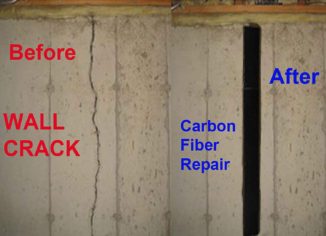For most homeowners, a damaged foundation can be a tremendous source of torture through sleepless nights—particularly when it’s the source for your bowed walls. In such circumstances, a bowed wall repair is needed but sadly, most homeowners tend to shrug off the idea. They usually consider a complete overhaul of the wall by tearing it down and erecting a new wall.
In extreme cases, the homeowner may consider repairing the foundation depending on the extent of the damage rather than replacing the whole foundation. It becomes an expensive affair and not feasible. You may end up jacking up the wall to provide temporary support as you excavate the foundation walls and floor slab.
Once this is done, a new foundation is built by pouring your floor and a new wall is put in place. But is such a method full proof? In other words, are we addressing the problem? Sadly, this isn’t the case. Despite the time, money and energy put into your bowed wall repair, the possibility of being plagued with the same dilemma is rife since you didn’t address the root cause— the soil surrounding your foundation.
What Causes a Bowed Wall?
Foundation walls bow due to a variety of reasons such as;
Soil Expansion
Clay soils are notoriously famous due to their expansive nature. Homes without gutters and proper drainage to divert water away from your foundation leads to oversaturation of soils around your foundation (hydrostatic pressure). The soil pushes against the foundation walls exerting pressure. Once it dries up, it shrinks. Continuous expansion and shrinking over time create weak spots in your foundation leading to cracks and bowing walls.
Tree Roots
Shrubs and trees can also be a major cause of bowed walls. Despite being planted far away from your foundation, their roots may travel further, exerting more pressure on the walls.
Seek the services of a trained or professional contractor to establish the root cause of your bowing walls in case you aren’t sure of the cause.
Time
Many homeowners disregard the fact that their foundation, just like their roof or siding, requires periodic maintenance. Over time, the waterproof coating on your concrete tends to wear out and break down. Periodic application of waterproofing will prevent your concrete from exposure to moisture. Why wait for your walls to discolor, bow or crack?
Poor Construction
A bowing wall may be a sign of rushed construction. Contractors further tend to take shortcuts such as backfilling before the concrete has fully cured. The soil tends to pile pressure pushing the unstable concrete pushing it inwards.
Having known the causes, let’s look at the options available on how to address such challenges.
Bowed Wall Repair Solutions
A bowed wall repair depends on the extent of the damage. However, you should note that repairing it doesn’t necessarily mean that the wall will go back to its original position. The repair aims to stabilize or secure the wall preventing advanced damage. Three common methods exist in carrying out a bowed wall repair.
Carbon Fiber Straps
This is a common repair method when your walls experience less than two inches of bowing. It’s cheap, fast, and less labor-intensive since no excavation is carried out. Once you spot cracks on your foundation wall, fill them up with epoxy or polyurethane injection before holding the walls in place with fiber straps. Such fiber straps come packed with a high tensile strength to hold the walls in place to avoid further cracking. For maximum results, attach the fiber straps to the sill plate above and the basement’s wall foundation for equitable stress distribution.
Wall Anchors
They are best suited to address bowing that exceeds more than two inches. Installation works need to be done both in and out of the basement with an allowable outward distance of about ten feet. A steel plate is attached to the basement wall while the other is buried ten feet away. They are both connected with a steel shaft which is tightened to exert pressure and hold the wall in place. Note that anchors should be placed at a five feet interval along the bowing wall.
Helical Tiebacks
They are the most expensive yet suitable if you don’t have the space to install wall anchors. A steel shaft with screw-like plates gets drilled at an angle from inside the basement to the outside of the earth’s basement. A large steel channel is used to secure the shaft from the floor extending up to the top of the wall, securing its structural ability. The tieback is twisted to the desired torque to increase rigidity.
The standard length of a tieback is usually 14-21 feet. However, in certain cases, longer lengths are required to bolster its grip.
As we wrap it up…
It is advised that you address the issue as soon as possible once you notice any signs of bowing to avoid significant damage, cost implications, and safety issues resulting from collapse.

